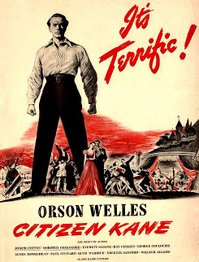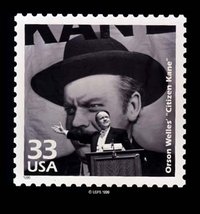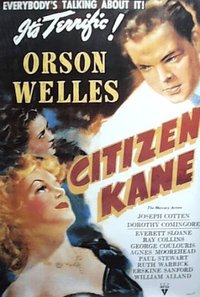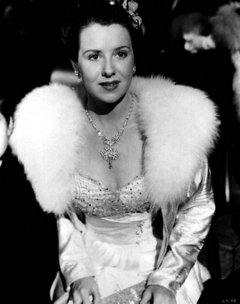Citizen Kane was the first feature film directed by Orson Welles (he had directed two short films previously), and is rumored to be based on the lives of the newspaper magnate William Randolph Hearst, the reclusive aerospace and movie mogul Howard Hughes, and the Chicago utilities magnate Samuel Insull. Welles maintained that the character is a composite of several historical individuals. In F for Fake Welles claims Kane was originally intended to be based on Hughes (to be played by Joseph Cotten) but he changed it to Hearst. Internally while it was under production, it was referred to as RKO 281. The film premiered on May 1, 1941. Endlessly discussed and dissected by critics and viewers alike, this innovative film is perhaps the most influential ever in film history.
The movie has some parallels to the 1933 movie The Power and the Glory.
The only remaining living cast member is Sonny Bupp who played Kane's young son, Charles Foster Kane III.
Robert Wise, who died of heart failure on September 14, 2005, was the last living crew member.
Overview
Produced in 1941, the film deals with the inability of Charles Foster Kane (played by Welles) to truly love. Instead Kane has only "Love on my own terms." As a result, Kane eventually alienates every loved one around him and dies a lonely recluse in an opulent, but crumbling estate.
Kane dies in the opening scene of the film; this is followed by a newsreel pastiche documenting Kane's public life (this segment was produced by RKO's actual newsreel department). The remainder of the movie is told through flashbacks being related to a reporter trying to improve the newsreel — the newsreel is regarded as functional but not especially profound, and furthermore the reporter is searching for the meaning behind Mr. Kane's dying word, "rosebud."
What is revealed has been described by Jorge Luis Borges, in a 1941 review, as a "metaphysical detective story. subject (both psychological and allegorical) is the investigation of a man's inner self, through the works he has wrought, the words he has spoken, the many lives he has ruined... Overwhelmingly, endlessly, Orson Welles shows fragments of the life of the man, Charles Foster Kane, and invites us to combine them and reconstruct him. Forms of multiplicity and incongruity abound in the film: the first scenes record the treasures amassed by Kane; in one of the last, a poor woman, luxuriant and suffering, plays with an enormous jigsaw puzzle on the floor of a palace that is also a museum. At the end we realize that the fragments are not governed by a secret unity: the detested Charles Foster Kane is a simulacrum, a chaos of appearances."
The film combines revolutionary cinematography (by Gregg Toland, with whom Welles shared a title card, which was an unprecedented gesture of Welles' appreciation for Toland's overall contribution to the film) with an Oscar-winning screenplay (by Welles and Herman J. Mankiewicz — though most film history circles consider Mankiewicz's contribution to the screenplay to be far greater than that of Welles), and a lineup of first time film actors, associates of Mr. Welles' from his stint at the Mercury Theater, such as Joseph Cotten and Agnes Moorehead.
Filmmaking innovations
Film scholars and historians view Citizen Kane as Welles' attempt to create a new style of filmmaking by studying the various forms of movie making, and combining them all into one (much like D. W. Griffith's The Birth of a Nation did in 1915). Examination of the techniques used by Welles and his crew reveals elements of expressionism in the use of light and shadow, noting the influence of German and Russian filmmakers. The film is even seen as one of the predecessors of method acting, as seen during the scene where Kane vents his anger at his political opponent, Jim Gettys, at the top of a flight of stairs. (Welles actually tripped and broke his ankle during the filming of that scene, but the scene continued and made it into the final print of the film.)
Read more at Wikipedia.org





